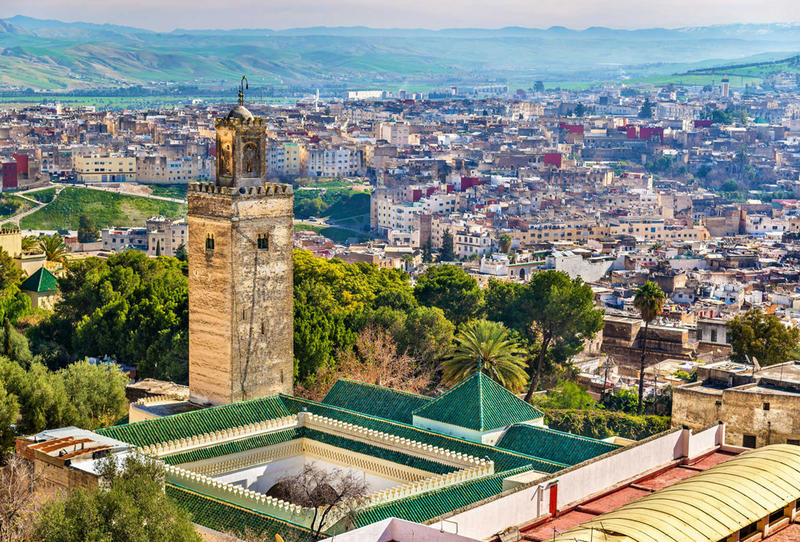Fez

Fez is an Arab Islamic city, located in the Kingdom of Morocco, and represents its scientific capital, and it is considered the largest city in the world in terms of being free of cars and vehicles. Fez occupies the northeastern part of the country, surrounded by forests, agricultural lands, and water springs. The number of its population was estimated, according to the statistics of 2018, at 964,891 which is considered a moderate populated among other Arabic cities. With regard to the economic aspect, the economy in Fez depends on the modern and traditional industries sector, the service sector, tourism, agricultural activities, and other fields.
Landmarks of Fez among other Arabic cities
The city of Fez includes a large number of historical monuments, magnificent palaces, and ancient mosques, which are considered an important center; To attract visitors and tourists from inside and outside the city, and the most important of these landmarks:
Mosques
The following are the most important of them:
Al-Qarawiyyin Mosque: It is one of the most important and prominent
historical religious monuments in the city, and the beating heart
of it, as it was completed in 859 AD by order of Fatima bint
Muhammad Al-Fihri, noting that it was named Al-Qarawiyyin. Relative to the al-Qarawiyyin neighborhood, which was inhabited by refugees coming from Kairouan.
Andalusian Mosque: it was established one year after the al-Qarawiyyin Mosque was established; That is, in the year 860 AD, and it is characterized by an amazing urban pattern; It is entered through huge doors decorated with ceramic tiles, and it has a ceiling clad in carved wood.
Mausoleum of Moulay Idris II: Moulay Idriss II is considered the
founder of the city of Fez , where he was buried in Zawiya Moulay
Idriss.
Hotels, fountains and museums
The following are the most important of them:
Lodges and hotels: represented hotels old accommodation for
traders, warehouses for their goods, which spread in the city of
Fez in abundance when the main axes of the old city; That is, near
the area of the great tales, the small ones, the carpenters, and
Ras al-Sharatain, in addition to the hotels near the major gates of
the city, namely: Bab Boujloud, Bab al-Kisa, and Bab al-Futuh.
Public Fountains: The city of Fez includes many fountains in its
public streets, which are distinguished by a wonderful artistic and
decorative character, including: the Carpenters’ Fountain, the El Hayek Market Fountain, and the Al-Qawas Fountain.
Museums: Including the Batha Palace, which is considered a museum
of wonderful pieces of art, of a local character in the city of Fez; It includes a large collection of embroideries, jewelry, copper utensils, carpets, and other traditional handicrafts . The city also has the villagers ’treasury, which was established during the seventeenth century, and contains about 32,000 archaeological manuscripts, including unique and rare documents of its kind dating back to Ibn Khaldoun, Ibn Rushd , and other great scholars .
Archaeological palaces
The following are the most important of them:
The Royal Palace: It is one of the historical palaces in Fez, where its construction dates back to the eighteenth century AD, and this palace includes at its entrance a wide yard built by the Alawites, in addition to large doors decorated and engraved on them.
The El-Glaoui Palace: It is the palace that Pasha inhabited the
city of Marrakech, Thami El-Glaoui, which is considered the most beautiful of Fez palaces, and includes among its walls about 1000 rooms, 30 fountains, two gardens, a Quranic school, a Moroccan bath for men, another for women, and a mill For the production of oil, and a mill for wheat.
Al-Maqri Palace: It is one of the ancient palaces with a distinctive architectural design. Its doors and walls are adorned with ebony, wrought iron, and scalpel, as well as carved domes, painted and combined with Baroque carpentry studded with Venetian glass.
Al-Menbhi Palace: It is one of the oldest palaces in the city. It was established at the end of the nineteenth century, and its construction continued by local architects for about 15 years, eventually emerging as a building, and an amazing masterpiece, noting that this palace is currently used as a restaurant that hosts gourmet visitors.
Read more about famous Arab Cities – The list of Arab Countries – List of Arab capitals
